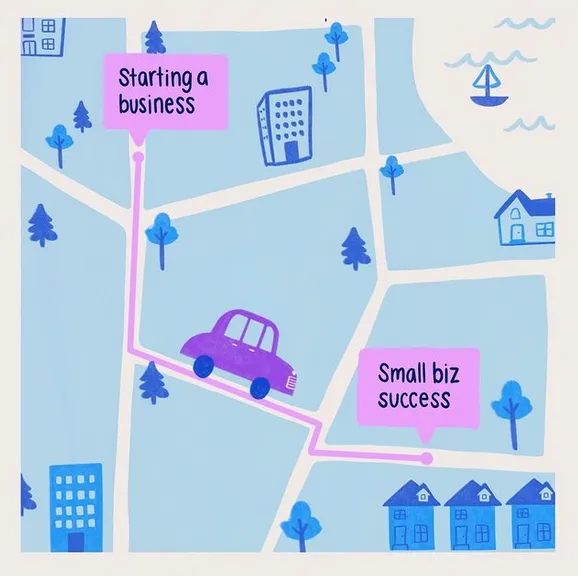
US Income Tax Starter Pack
Congratulations on becoming your own boss! It takes a lot of moxie to take the leap as a small business owner, and we here at Wave are behind you 100%.
In our experience, most self-employed folks are comfortable doing the work – but managing the technical aspects of a business (ie, paying business income taxes) comes less naturally. If this is you, we’ve put together this quick-start guide to give you the answers to some of our most commonly asked tax questions, and share tips to help you maximize your savings when tax season rolls around.
Here’s what we’ll cover today:
- The ins and outs of Form 1040, Schedule C
- Common tax deductions (+ writeoff cheat sheet)
- How (and when) to pay your taxes
Let’s get started.

To C or not to C (Schedule C, this is)
As a small business owner, one of the first decisions you made was how to structure your business. In other words, did you “hang out a shingle” and get started without any formalities? In that case, your business is considered a sole proprietorship. That means that you are the business.
However, it’s also very popular to create your business as a single-member LLC, meaning that your business is a separate legal entity from you. Doing this protects your personal assets from business liabilities or legal issues.
In the tax world, both sole proprietorships and single-member LLCs file their income taxes on the personal tax return of the owner. This means that both your business income and expenses will be reported on your (the owner’s) Form 1040, Schedule C.
Let’s talk taxes
As a Schedule C filer, you (the business owner) will be paying two different kinds of taxes on your business income:
- Income taxes
- Self-Employment taxes
Income taxes are calculated on your total taxable income as a percentage of your total income. When people talk about tax brackets, they’re referring to income tax.
Self-employment taxes are calculated on your net self-employment earnings, which is calculated on Schedule C. The rate is 15.3%, but half of those taxes are allowed as a deduction against your total taxable income.
Whoa! 15.3% sounds like a lot! And that’s on top of my income taxes?
Yep, it can come as a surprise, but there is a logic behind self-employment tax. It’s all about payroll taxes: Social Security and Medicare. These are the payroll taxes that are withheld from wages if you earn a paycheck; the withholding percentage for an employee is 7.65%, and the employer pays the other 7.65% as a business expense.
The rub is that since you’re self-employed, you’re responsible for both the employer and employee portion of payroll taxes on the net income you earned in your business. In addition, since you don’t file separate payroll tax returns, the total amount of payroll taxes for the entire year is calculated and due on your annual personal income tax return (Form 1040).
This can lead to sticker shock for a new business owner, but there are a couple of silver linings:
- The “employer half” of the self-employment tax is deducted from your taxable income and therefore reduces your income tax liability.
- Self-employment tax is calculated on the net income of the business, not the gross income, so the lower you can get your total business net income, the less self-employment tax you’ll need to pay. We’ll talk more about that later!
If it helps, try not to think of self employment tax as a real tax. Think of it as a retirement and insurance plan, since it’s actually your contribution to your government retirement, survivor and disability plan and medical insurance. You will get some of it back as social security benefits after you retire, if you become disabled, or as benefits paid to your spouse if you pass away.
You’ll also receive medical benefits after you reach the eligible age and contribution requirements. The more you contribute to social security, the higher the benefit!
Getting down to brass tax (get it?)
Now let’s go over some of the most common tax and accounting questions that small business owners ask us:
1. How is business income tax calculated?
If you’re a Wave Advisors customer, we’d use the Profit & Loss report in Wave as a starting point, since you’ve already done the work to enter and categorize all of your transactions and reconcile your accounts.
Then we’d make adjustments for items in Wave that can’t go straight on the tax return – for example, non-deductible expenses like income tax payments, and non-taxable income like PPP loan forgiveness. Then we’d make sure we haven’t missed anything else that’s not in Wave, like depreciation, business expenses that were paid personally, or other potential deductions.
Cash or Accrual - what does that mean?
The first year that you file a tax return for your business, you need to choose an accounting method, and the two most common are cash and accrual:
- Cash based accounting means that you report income when you receive it, and claim expenses when you pay them except when you purchase capital assets (see depreciation in item 2 below) or inventory that hasn’t been sold yet.
- Accrual based accounting means that you report income when you invoice your customer, and report expenses when you are billed for them.
Most small businesses use the cash method because otherwise you pay tax on income you haven’t been paid yet, which isn’t great for cash flow. You can read more in our Help Center article if you’re still curious!
2. Do I need to run payroll to pay myself a salary from my Schedule C business?
You can pay yourself by taking money directly out of your business and depositing it into your personal account, without needing to pay yourself via payroll or submitting a Form W-2, Wage and Tax Statement to the IRS.
3. What’s a 1099-NEC? Do I need to do that too?
1099-NEC is an IRS form that summarizes what your business has paid to a contractor or freelancer during the calendar year. It is the IRS’ way of making sure that independent contractors pay their share of taxes, so they make business owners report the contractor's income on these 1099-NEC forms.
You must provide the form to any contractor you paid $600 or more (again, during the calendar year) via cash, check or direct transfer (for instance Venmo, CashApp, or Zelle). Too much of a hassle and don’t want to file? No problem! Simply pay your contractors via credit card or Paypal and you won’t need to deal with this; the payment processor is responsible for filing the necessary forms. If you are a freelancer or contractor you may also receive Form 1099-NEC from your customers for the amounts paid to you.

4. What’s depreciation?
Depreciation is how you write off the cost of capital assets over the period of time they are in use. Capital assets are assets used for longer than one year, and that cost over $2,500 each. Common examples include vehicles, buildings, machinery, and property improvements. If you purchased any assets for more than $2,500 last year, be sure to keep a copy of the receipt, invoice, or other purchase documents. You can read more about capital assets in this Help Center article.
Can I request my car to be written off?
Yes and no. Let’s go through a few key points:
- The trick to vehicle expenses is that you must maintain a mileage log for all business and personal use of your car; the IRS will disallow any vehicle deductions in the case of an audit if you can’t provide detailed documentation.
- Once you have your mileage log, we compare the business miles to the personal miles, and calculate the allowable deduction based on business use percentage. Note that commuting miles from your home to your office or regular place of business do not count as business miles. You can choose either the standard mileage method, meaning you claim a certain amount per mile (which the IRS publishes each year), or you can choose the actual expenses method, meaning that you will claim the amounts you actually paid plus allowed depreciation. You can choose whichever provides the largest deduction each year, as long as you claim the standard mileage method in the first year you began using the vehicle for your business.
- Buying a new vehicle used primarily for business can generate considerable tax savings in the year of purchase, since the depreciation rules for vehicles are quite generous. If you purchased a vehicle and used it for your business during the year, be sure to provide a copy of the purchase documents to your tax preparer.
What about the office I set up at home? Is that deductible?
The portion of your expenses that apply to a home office is deductible as a business expense. The business portion is calculated by comparing the area of the office space to the total area of the home. Here’s what you need in order to claim home office expenses:
1. For the business percentage calculation:
- Square footage of house
- Square footage of office
2. Total annual expenses:
- Mortgage interest
- Real estate taxes
- Homeowner's or renter’s insurance
- Mortgage insurance
- Repairs and maintenance
- Rent (Non-homeowners only)
- Utilities (electricity, internet, heat, etc.)
- Casualty loss
- Any direct expenses that are used 100% in the home office for business
- Other expenses
3. If you own the home, you also need to provide:
- Purchase price of house
- Land included in purchase price (if you are unsure of the land cost, look at your property tax bill to see if they provide a split. Otherwise you can use 20% of the purchase price as land)
- Any improvements or renovations made to the house (landscaping doesn’t count)
- Month and year you started using the office space
- Fair market value on that date
- Land included in fair market value
Please note you cannot claim home office expense if you have a regular office outside of your home. The home office also has to be a dedicated office space 100% for work only - it can't be where you also stream movies or watch tv for leisure.

What about expenses that I pay for business and personal use, like my cell phone?
Business calls that you make on your personal cell phone are deductible! Simply estimate the percentage of your phone usage that is for your business, and multiply that by the total cost of your phone over the year. You can enter it in Wave as an Owner Investment; see this Help Center article for more detail on how to do that.
What about health insurance?
Good news: the cost you pay for your health insurance is a dollar-for-dollar reduction of your taxable income, so be sure to keep records of your insurance costs! The entire amount of your health insurance premiums is eligible - it doesn’t need to only cover you; it can cover your spouse and dependents as well - so be sure to keep track of your annual insurance costs. It’s worth noting that you can’t deduct health insurance if you or your spouse are eligible to participate in an employer-subsidized health plan.
Are meal and travel expenses tax deductible?
In general, business meals are only 50% deductible for tax purposes. But keep in mind that going out for a meal by yourself is non-deductible unless you are travelling away from the general area where you reside or work for business purposes, and it’s necessary for you to stop for substantial sleep or rest to properly perform your duties. The meal also must not be lavish or extravagant and should be with an employee of the business or somebody who has a relationship with your business, such as a client or potential customer.
The same rules apply to travel expenses: it includes necessary expenses of travelling away from home for your business, and you cannot deduct lavish or extravagant expenses or that are for personal purposes. Deductible travel expenses while away from home include, but are not limited to, the costs of:
- Travel by airplane, train, bus or car between your home and your business destination
- Fares for taxis or other types of transportation
- Lodging and non entertainment related meals
Feeling confident you know what you can expense? Take our “Can I claim this?” tax quiz.
Want the full menu of items that are tax deductible? We’ve put together this handy cheat sheet for you:
Home stretch: How (and when) to pay your taxes
As a Schedule C filer, all of your taxes will be calculated on your annual income tax return, but they should be paid via estimated tax installments.These payments are due at four times during the year:
- April 15
- June 15
- September 15
- January 15
Each payment should each cover ¼ of what you’ll owe when you file your tax return the following year. Of course, since you won’t know exactly the amount of taxes due, you’ll need to make an educated guess based on your current tax return and expected income for the following year. Most taxpayers can rely on their previous year’s tax liability to calculate their current year estimated tax payments to avoid penalties. If you’re a Wave Advisors customer, we’ll talk more about estimated tax payments once we have your information.
We don’t talk about crypto
Now that we’ve covered Schedule C, let’s go into a few other tax topics that we see pretty often:
- Rental properties: this includes anything from a 50-unit apartment building to airbnb-ing a spare bedroom. Be sure to keep records of all rents received and all expenses paid (property taxes, mortgage interest, property management fees, etc.). Rental property must be depreciated, so you’ll need to provide the original closing statement/HUD settlement statement for the property. Also, if the rental space is in your personal home, you should provide the square footage of both the rental space and the total area of your home.
- Cryptocurrencies: trading and transacting in cryptocurrencies has exploded in the past couple of years, as they have been embraced by mainstream brokerages and payment processing companies. It’s important to know that the IRS has ruled that cryptocurrency transactions must be reported as capital gains or losses - including converting or trading one cryptocurrency for another cryptocurrency. Any payments for services that you receive as cryptocurrency must be reported as income equal to the fair market value of the crypto when you received it. In addition, it’s absolutely critical to keep records of the purchase and sales prices of each cryptocurrency transaction in US dollars, so that the gains or losses on each transaction can be properly calculated.
- Capital gains and losses: buying and selling old-fashioned stocks, mutual funds, and ETFs might seem dull compared to crypto trading, but there’s certainly no slowdown in stock market trading these days. One important rule to know about is the wash-sale rule. It was put into place by the IRS to prevent people from harvesting losses on investments just for the tax benefit. It works like this: let’s say you buy 10 shares of Best Buy on January 10th, and sell it at a loss of $50 on August 12th. If you buy another 10 shares of Best Buy on August 31st, the $50 loss won’t be reported on your tax return; it’s deemed to be “disallowed” and can’t be used to offset any capital gains. Your brokerage tax document (1099-B) will have this information; it’s a good idea to look out for this tax trap before you fall into it.
- Personal deductions: the Tax Cuts and Jobs Act greatly reduced the number of taxpayers who benefit from itemizing their deductions, but if your personal deductions are higher than the standard deduction, it makes sense to claim them! Typically you’ll want to consider itemizing if you pay a lot of mortgage interest, medical bills, charitable contributions, property taxes, or state income taxes. Keeping your receipts and tax documents will make it easier to figure out what saves you the most money.

As you can see, there are a lot of income tax deductions available to small business owners. The first step is knowing what’s fair game (you can check that one off the list!); the second one is staying organized. Now is the perfect time to start keeping a mileage log, take note of your home office square footage and travel expenses. With a little planning, you’ll be in great shape for tax season.
(and create unique links with checkouts)
*While subscribed to Wave’s Pro Plan, get 2.9% + $0 (Visa, Mastercard, Discover) and 3.4% + $0 (Amex) per transaction for the first 10 transactions of each month of your subscription, then 2.9% + $0.60 (Visa, Mastercard, Discover) and 3.4% + $0.60 (Amex) per transaction. Discover processing is only available to US customers. See full terms and conditions for the US and Canada. See Wave’s Terms of Service for more information.
The Wave Advisors team is standing by to answer your questions and make sure all your information is up to date.
The information and tips shared on this blog are meant to be used as learning and personal development tools as you launch, run and grow your business. While a good place to start, these articles should not take the place of personalized advice from professionals. As our lawyers would say: “All content on Wave’s blog is intended for informational purposes only. It should not be considered legal or financial advice.” Additionally, Wave is the legal copyright holder of all materials on the blog, and others cannot re-use or publish it without our written consent.


























